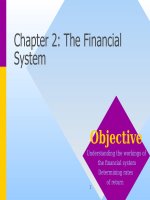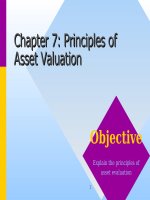Corporate finance chapter 09 valuation of commen stocks
Bạn đang xem bản rút gọn của tài liệu. Xem và tải ngay bản đầy đủ của tài liệu tại đây (178.89 KB, 20 trang )
Chapter 9: Valuation of
Common Stocks
Objective
Explain equity evaluation
using discounting
1
Dividend policy
and wealth
Chapter 9 Contents
9.1 Reading stock listings
9.2 The discounted dividend model
9.3 Earning and investment opportunity
9.4 A reconsideration of the price multiple
approach
9.5 Does dividend policy affect shareholder
wealth?
2
Reading Stock Listings
Yr Hi
Yr Lo
123 1/8 93 1/8
Stock
IBM
Sym
IBM
Div
4.84
Yld %
4.2
PE
16
Vol 100
14591
Day Hi
Day Lo Close
115
113
Net Chg
114 3/4 +1 3/8
3
Present Value of Dividends
D1
D2
D3
D4
P0 =
+
+
+
+ ...
1
2
3
4
(1 + k ) (1 + k ) ( 1 + k ) (1 + k )
D3
D1
1 D2
D4
=
+
+
+
+ ...
1
1
1
2
3
(1 + k ) (1 + k ) ( 1 + k ) ( 1 + k ) ( 1 + k )
D1
1
D1 + P1
{ P1} =
=
+
1
1
1+ k
(1 + k ) (1 + k )
D1 + P1 − P0
k=
P0
4
Expected Rate of Return
• The price and dividend next year are
expected prices, so
– The expected rate of return in any period
equals the market capitalization rate, k
D1 + P1 − P0
k=
P0
5
Rate Relationship
D1 + P1 − P0 D1 P1 − P0
k=
=
+
P0
P0
P0
• This relationship tells you that next
year’s expected dividend yield + the
expected capital gain yield is equal to the
required rate of return
6
Price0 Is Discounted Expected
(Dividend1 + Price1)
• Price is the present value of the expected
dividend plus the end-of-year price
discounted at the required rate of return
D1 + P1
P0 =
1+ k
7
Ease of Use
• Recall from chapter 4 that, for a perpetuity,
the present value is the real value of the
first cash flow divided by the real rate
Dreal
p0 =
=
R
Dnominal @ 1
(1 + g )
R
8
Putting This Together
D1
p0 =
=
(1 + g ) R
D1
1+ k
(1 + g )
− 1
1+ g
D1
D1
=
=
(1 + k ) − (1 + g ) k − g
9
Solving for K
D1
p0 =
⇔
k−g
D1
k=
+g
p0
10
G = Capital Gains Yield
• Comparing prior results:
D1
k=
+g
p0
D1 P1 − P0
& k=
+
P0
P0
P1 − P0
⇒ g=
P0
11
Earning and Investment
Opportunity
• To simplify the analysis, suppose that no
new shares are issues, and no taxes
Dividends = earnings - net new investment
“D = E - I”. The formula for valuing stock is
∞
∞
∞
Dt
Et
It
p0 = ∑
=∑
−∑
t
t
t
t =1 (1 + k )
t =1 (1 + k )
t =1 (1 + k )
12
Growth Stock
80
80
80
wealth = 100 * (0.4 + 0.6 * * (0.4 + 0.6 * * (0.4 + 0.6 * * (...))))
60
60
60
wealth = 100 * (0.4 +
Kept
Original wealth
0.8 * (0.4 +
0.8 * (0.4 +
0.8 * (...))))
Wealth Multiplier
Reinvested
13
Growth Stock
wealth = 100 * (0.4 + 0.8 * (0.4 + 0.8 * (0.4 + 0.8 * (...))))
= 100 * 0.4 * (1 + 0.8 * (1 + 0.8 * (1 + 0.8 * (...))))
wealth = 100 * 0.4 * (1 + 0.8 + 0.82 + 0.83 + ...)
1
= 100 * 0.4 *
1 - 0.8
= $200
1
1 + a + a + a + ... =
1− a
2
3
14
Generalize
• Let the
– V = value of the shares without reinvestment
– G = the growth from new investment
– R = retention ratio
– M = wealth multiplier = g/i
– Wealthg = wealth0*(1-r)/(1-w*r)
15
Reinvestment Under Normal
Growth
6
Price =
= $100
0.15 − 0.6 * 0.15
Cost of Capital
Retention Ratio
16
Growth Rate
Illustration: Dividends
Assets
Cash
Liab\Equ
2
Debt
2
Other
10
Equity
10
Total
12
Total
12
17
Illustration: Dividend Payment
Was 2
Assets
Cash
Was 10
Liab\Equ
1
Debt
2
9
Other
10
Equity
Total
11
Total
18
11
Were 12
Illustration: Share Repurchase
Assets
Cash
Liab\Equ
2
Debt
2
Other
10
Equity
10
Total
12
Total
12
19
Illustration: Share Repurchase
Was 2
Assets
Cash
Was 10
Liab\Equ
1
Debt
2
9
Other
10
Equity
Total
11
Total
20
11
Were 12









